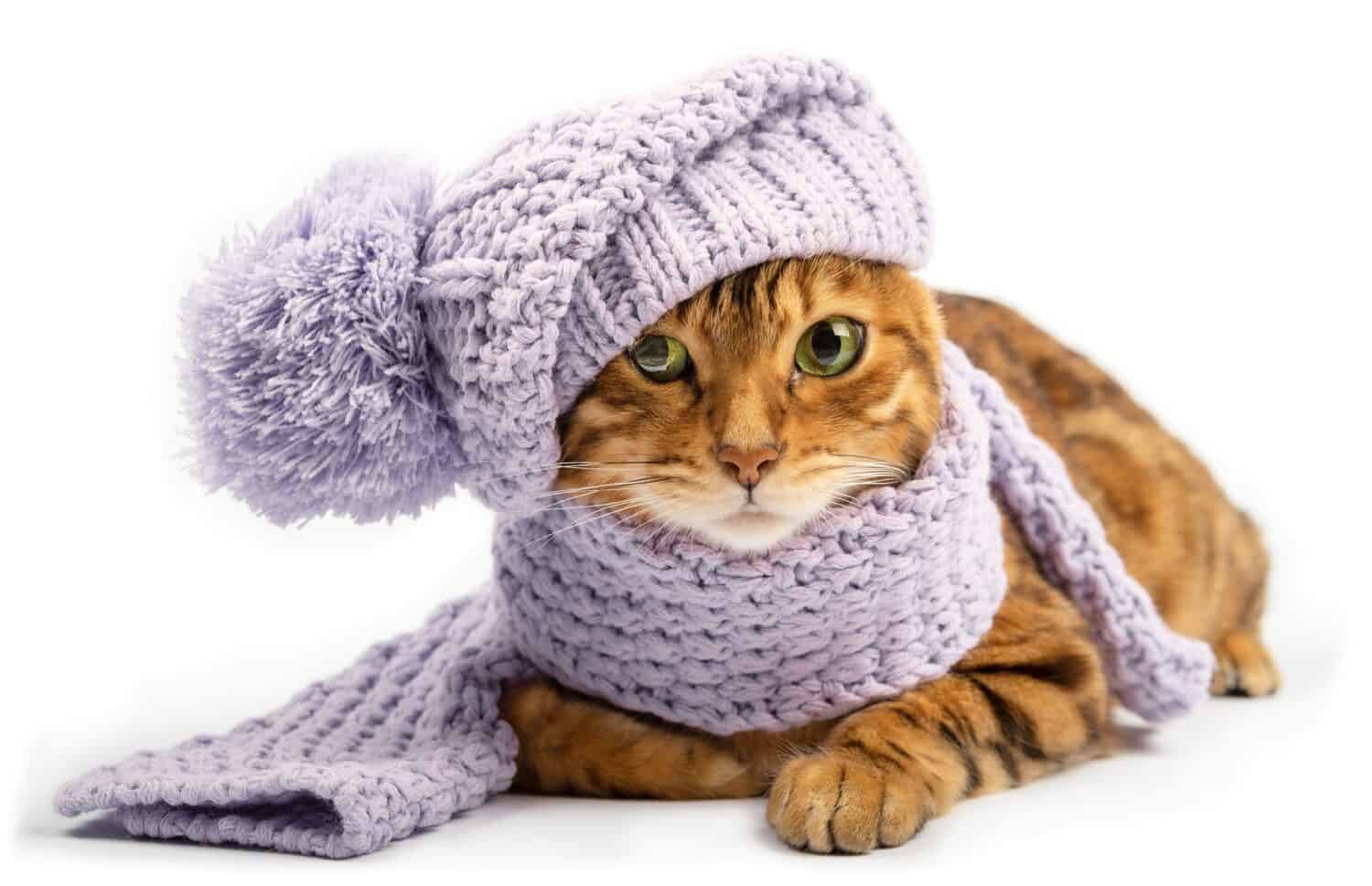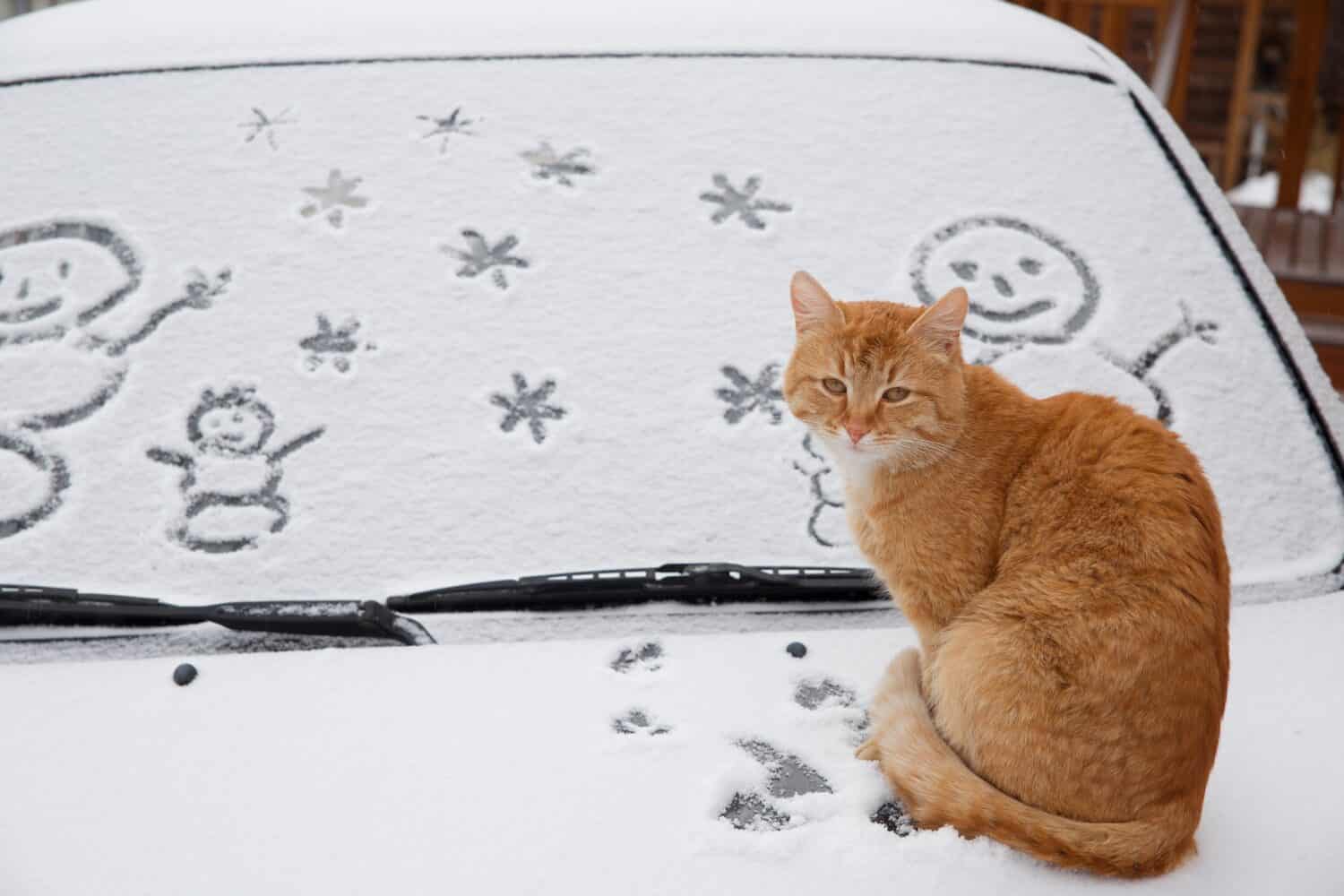
Cats may have fur, but they are still very susceptible to frigid temperatures. Anything below 45 degrees Fahrenheit is too cold for our furry friends.
©Svetlana Rey/Shutterstock.com
Winter is full of splendor, with its dazzling snow, crisp air, and a sense of enchantment. It is also the season for skiing, snowshoeing, curling up with our cats and a good book by the fire, spending time with our favorite humans, and drinking delightfully hot beverages that warm us up from the inside out.
However, despite their many charms, the long, cold months of winter can be a difficult time for our beloved cats. Frigid temperatures bring extra dangers, putting them at greater risk for cold-related illnesses. In particular, frostbite and hypothermia are the primary concerns when temperatures plummet. Cats’ adorable little ears, paws, and tails are particularly vulnerable to frostbite and they can also suffer from hypothermia, a dangerous and life-threatening condition. In addition, older cats, kittens, cats with health issues, and breeds with thin or no coats – like the Cornish Rex or Sphinx – are at a greater risk from the perils of arctic weather and require extra protection, including sweaters and blankets.
Despite the misnomer that because most cats wear fur coats, they are therefore able to withstand the cold, in reality, their normal body temperature runs from 99.5 to 102.5 degrees Fahrenheit. This means it is actually easier for them to feel the chill of brisk air than it is for us! And while we can put on extra layers and bundle up, cats rely on us to keep them cozy and safe.
So to answer the pressing question – how cold is too cold for cats – veterinarians generally agree that anything below 45 degrees Fahrenheit is an important guiding number. Keep it in mind when letting your cats outside, even if they are used to being outdoors. Another simple rule of thumb is this: if it is too bitter cold for you, it is also too severe for your cat.
Read on to find out how to keep your cat warm and cozy all winter long.
Brrr….Avoid Frostbite and Hypothermia When Temperatures Plummet
Frostbite and hypothermia are both extremely dangerous conditions that are never to be taken lightly. In fact, both require immediate veterinary attention. Understanding the signs of each will help you know when to seek professional help. In both cases, an abundance of precaution is key because cold-related illnesses are entirety preventable.
Let’s start with the frostbite. Just like humans, cats are susceptible to having sensitive tissues freeze due to prolonged exposure to icy temperatures. Their extremities, such as the ears, tail, and paw pads, are particularly vulnerable. Signs of frostbite in cats include pale or discolored skin, swelling, pain, and blisters. If you suspect your cat is suffering from frostbite, seek veterinary attention immediately, as treatment is crucial to prevent tissue damage and infection. In these cases, veterinarians will treat your cat by administering antibiotics and pain medications because thawing tissues can be excruciating.
Likewise, hypothermia is a medical emergency that requires immediate veterinary care. It occurs when a cat’s body temperature drops below normal – usually due to prolonged exposure to cold weather without proper shelter or insulation. Symptoms include shivering, lethargy, cold and pale skin, weakness, and difficulty breathing. If you think your cat is suffering from hypothermia, wrap them in warm blankets and then go straight to the doctor.
Finally, cats are notorious for masking their pain. In fact, hiding any vulnerability is an evolutionary advantage that has helped keep them safe from predators whenever they are sick or injured. However, this trait can be dangerous for beloved companions if we do not learn to discern the signs that they are suffering and need our help. If you cat has been stuck outside and has any of the symptoms listed above, get medical backup ASAP.
Above all, protect them from the elements so they do not get frostbite or hypothermia in the first place.
If it is a Winter Wonderland Outside, Bring Cats Indoors

As cute as this photograph is, it is best to bring cats inside during arctic conditions.
©Serrgey75/Shutterstock.com
The best way to keep cats safe and warm during frigid weather is to keep them nice and cozy in your home. Indoor cats have a significantly reduced risk of exposure to extreme temperatures, predators, and various outdoor hazards. Creating an inviting indoor environment with comfortable bedding, access to warm areas, and ample playtime can help ensure their well-being and prevent boredom.
When temperatures drop, be sure your cat has access to warm and cozy areas around your house. Place cat beds in spots away from drafts or cold floors. You can also add blankets or heating pads designed for pets to provide extra warmth. Just make sure to use pet-safe heating elements and keep a close eye on them to prevent accidents.
Also, keep your home at a temperature that is comfortable for both you and your feline friend. Avoid sudden temperature changes and seal any drafts by properly insulating windows and doors. When you venture out of the house, never leave your cat alone in an unheated environment.
If your cat tolerates clothing, you can explore using cat-sized sweaters or jackets to add an additional layer of warmth. These are especially important for cats with thin or no fur. Introduce clothing gradually, and monitor your cat’s comfort and mobility to ensure they are at ease.
By providing warm sleeping spots, maintaining a comfortable ambient temperature, and using sweaters and blankets, you can help keep your feline companion cozy and content during colder weather.
Caring for Community Cats

Community cats who live outdoors are at an increased-risk of cold. You can help them by setting up insulated outdoor shelters and giving them fresh food and water in heated bowls.
©Maria T Hoffman/Shutterstock.com
Finally, let’s talk about our feline friends who we absolutely cannot bring inside. Community or feral cats, who live outdoors, face significant challenges during cold weather. If you are a community cat caretaker, you can set up insulated outdoor shelters with straw bedding to protect your cats from the elements. These shelters should be enclosed, elevated off the ground, and have multiple exits to prevent trapping cats inside in a blizzard. Ensure feral cats have access to fresh food and water. During colder months, water can freeze quickly, so consider using heated bowls or providing warm water several times a day. You can also collaborate with local animal welfare organizations or community cat programs that are trained to provide assistance with trapping, neutering, and returning feral cats. These organizations often offer additional resources and advice on caring for feral colonies during winter.
When it comes to cold weather, cats are generally safer and happier indoors. By providing a warm and stimulating indoor environment, we can ensure their well-being throughout the winter months. For feral cats, offering shelters, food, and water can help them withstand the challenges of the cold season. Remember, the health and comfort of our feline friends should always be a priority, no matter the weather outside.
Thank you for reading! Have some feedback for us? Contact the AZ Animals editorial team.








